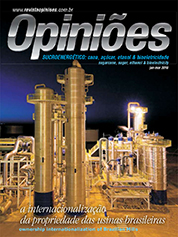Luciano Medeiros Prado
Superintendent for Agribusiness of Banco Votorantim
Op-AA-23
New perspectives for the sugar and ethanol industry
The internationalization process brings about important changes in the biofuel market, affording the consolidation and verticalization movement much more power and speed. The increase in the share of foreign capital, which already corresponds to more than 20% of the crushed volume, with important participation in four of the seven major players, is inevitable and has provoked a favorable initial reaction on the part of the financial market.
Furthermore, the recent announcement of the Cosan joint venture is a historical mark, which materializes an old intention of the industry: the vigorous entry of an oil giant. But, after all, what is it that drives these large multinational companies? Certainly a combination of factors, of which we highlight:
Opportunity: highly attractive assets, with possibilities for ROIC, clear growth and consolidation potential (given the high degree of fragmentation);
Market Access: we are the best positioned country to meet world demand;
Vocation: we have experience, natural resource availability and the capacity to rapidly expand production;
Macroeconomic Fundaments: undoubtedly we are the foreign investor’s preference.
Apart from contributing to the sugar-based energy industry’s maturing, we may think of the following effects of internationalization:
Capacity to Compete: increase in the sophistication level of risk management, market intelligence, scale and competitiveness, in addition to access to markets;
Infrastructure: Access to technology and investment in infrastructure: incentive for biotechnology;
Synergies: creation of value through integration;
Transformation of Ethanol to a Commodity: to attenuate price oscillations and allow the celebration of (financeable) long term contracts. However, issues such as the lack of an established international market, protectionism, certification, continuous offering on a large scale by several countries, cyclicity and logistics structure persist as reasons for concern and will require maximum efforts and more coordination by the industry.
What changes do we envisage in risk perception in the industry based on what was described, from the viewpoint of the financial market? Most financial agents operate with similar rules for granting the industry credit, which take into consideration quantitative and qualitative aspects and are based on the following pillars:
Concept: experience in business, relationships, management and governance;
Operational Performance: in agriculture and industrial, and
Financial Performance: payment capacity, worthiness, access to capital and financial strategy, adjusted for complexity, unpredictability of results and the industry’s heterogeneity.
Having said that, we believe internationalization may positively affect the following credit metrics:
Rating improvement: in general, M&A (mergers and acquisitions) operations are in tandem with financial recovery measures: pay-in of new capital and/or amortization of the more costly short term debt. Such change in capital structure has provided mills more muscle and financial breathing capacity. In some cases, such improvement is also the result of a capitalization plan involving the demobilization of assets; in other cases, because the new controller’s activities are predominantly outside the sugar industry, it affords the benefits of risk diversification.
Management: commodity is cost. Therefore, competence in management is vital! Even acknowledging several improvements in the professionalization of several Brazilian groups, the crisis evidenced the issue, which requires more dynamic management, characteristic of business organizations as opposed to family-run businesses.
More financial discipline: The 2008 crisis was not painless for the industry, and was characterized by a clean-up in the form of Court-sponsored recoveries. Financial austerity and planning with the contention of excesses may prevent the vicious cycle one observed in the crisis. In this regard, the possibility to access multinationals’ capital may be a differential.
We will only know the main results of internationalization in the future. However, notwithstanding the consequences of the crisis, the risks inherent to the activity, and the pending challenges, we have a positive outlook for the industry due to the upholding of its fundaments. With the return of profitability, better conditions in the capital market, and the positive effect of several restructurings - operational, corporate and financial -, we anticipate the normalization of credit for the industry, now no longer only Brazilian, but global.




